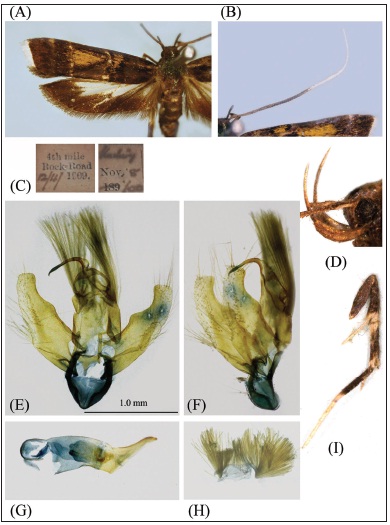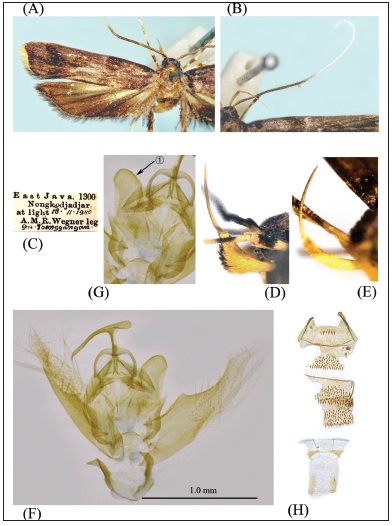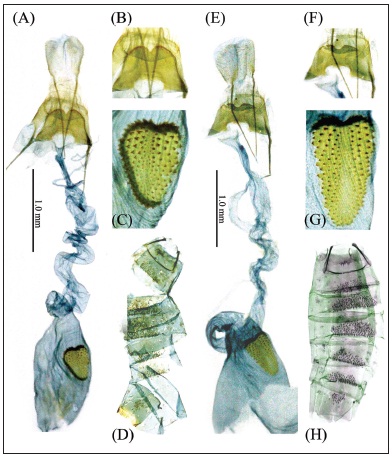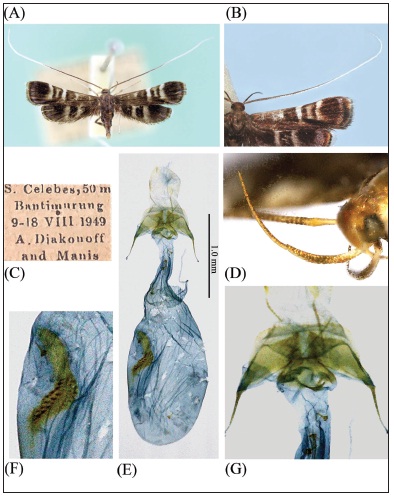

Artículos
Review of three little-known genera, TirizaWalker, 1864, Siovata Walker, 1886, and Trypherogenes Meyrick, 1931 of Lecithoceridae (Lepidoptera: Gelechioidea)
Revisión de tres pequeños géneros conocidos de Lecithoceridae, Tiriza Walker, 1864, Siovata Walker, 1886 y Trypherogenes Meyrick, 1931 (Lepidoptera: Gelechioidea)
Review of three little-known genera, TirizaWalker, 1864, Siovata Walker, 1886, and Trypherogenes Meyrick, 1931 of Lecithoceridae (Lepidoptera: Gelechioidea)
SHILAP Revista de Lepidopterología, vol. 46, no. 183, 2018
Sociedad Hispano-Luso-Americana de Lepidopterología
Received: 17 January 2018
Accepted: 10 February 2018
Published: 30 September 2018
Abstract: Three poorly known Oriental genera of the Lecithoceridae; Tiriza Walker, 1864, Siovata Walker, 1886, and Trypherogenes Meyrick, 1931, are reviewed. Since the former two genera were described and later it was synonymized with Lecithocera Herrich-Shäffer by MEYRICK (1910), there has been much confusion about the generic identity as synonyms of the latter or valid genera respectively. However, it is confirmed that they are clearly different from Lecithocera, and Siovata Walker, syn. n. is a junior synonym of Tiriza Walker by having the similar wing color pattern including the venation and the genital diagnostic characters. Tiriza pulcherrimella (Walker, 1866), comb. n. is newly combined. In addition, the genus Trypherogenes Meyrick has been placed in the family Gelechiidae, but it is removed to Lecithoceridae, due to the antenna distinctly longer than forewing. For these two valid genera, redescriptions of adults and illustrations of the genitalia of both sexes are provided.
Keywords: Lepidoptera, Lecithoceridae, Siovata, Trypherogenes, Tiriza, review synonym, India.
Resumen: Se revisan tres géneros orientales poco conocidos de Lecithoceridae; Tiriza Walker, 1864, Siovata Walker, 1886 y Trypherogenes Meyrick, 1931. Desde que los dos géneros fueron descritos y después fueron puesto en sinonimia con Lecithocera Herrich-Shäffer por MEYRICK (1910), ha existido mucha confusión tanto sobre la identidad genérica como sobre las sinonimias de este último o los géneros válidos respectivamente. Sin embargo, está confirmado que son claramente diferentes de Lecithocera y Siovata Walker, syn. n. es una nueva sinonimia de Tiriza Walker teniendo similar el dibujo alar incluyendo la venación y el diagnóstico característico de la genitalia. Tiriza pulcherrimella (Walker, 1866), comb. n. es una nueva combinación. Además, el género Trypherogenes Meyrick ha sido puesto en la familia Gelechiidae, pero es trasladado a Lecithoceridae, debido a la antena, claramente más larga que las alas anteriores. Para estos dos géneros válidos, se proporciona la redescripción de los adultos y se ilustran la genitalia de ambos sexos.
Palabras clave: Lepidoptera, Lecithoceridae, Siovata, Trypherogenes, Tiriza, sinonimias revisadas, India.
Introduction
Genera Tiriza Walker, 1864, Siovata Walker, 1886, and Trypherogenes Meyrick, 1931 were described as monotypy respectively. Since they were described with only brief descriptions by WALKER (1864, 1886) and MEYRICK (1931), their generic status have been much confused because of no further detail information concerning on diagnostic characters available, except the guide book by ROBINSON et al. (1994). The genus Tiriza Walker was established with type species T. leucotella Walker, 1864, from Sarawak, Malaysian Borneo, placing originally in Gelechiidae, but it was synonymized with Leithocera Herrich-Shäffer by MEYRICK (1910). SATTLER (1973) also treated it as a junior synonym of the latter and automatically was placed in the Lecithoceridae. However, the type species clearly differs from Lecithocera by having well-developed spinous zones on abdominal tergites and the male genital character without the costal bar connecting tegumen and valva. ROBINSON et al. (1994) treated Tiriza Walker and Siovata Walker as valid genera respectively. The two genera were then adopted as valid by various online databases including the Global Lepidoptera Names Index by the Natural History Museum (BECCALONI et al., 2005-2010). The genus Siovata Walker was described from Java, Indonesia, based on the type species T. pulcherrimella Walker, 1864. However, the genus is synonymized with Tiriza Walker in this paper by having similar external characters as followings: the antenna distinctly longer than forewing, blackish or purplish about in basal half, then silvery-white beyond; the elongated forewing with similar color pattern with orange-white fringes similarly along termen, the hindwing with pale-orange patches extending from near base to beyond middle, and the male genitalia with similar diagnostic characters, except the different shape of the gnathos. The genus Trypherogenes Meyrick was also established as monotypy with type species T. chrysodesma Meyrick, 1931, from Celebes, Indonesia. It was originally placed in the Gelechiidae, and MEYRICK (1931) mentioned that the species seems belonging to the group of Lecithocera, or related to the genus Habrogenes Meyrick, 1918. The genus has been placed in the Gelechiidae by CLARKE (1965) and also the names index of the Natural History Museum (BECCALONI et al., 2005-2010). Even though the species has the antenna longer than forewing which is a major apomorphic characters of the Lecithoceridae, the shape of wings looks some different from other species of the family. Thus, it is tentatively placed in the family Lecithoceridae in this paper.
The aim of this paper is to review these genera and species, providing re-descriptions of adults, descriptions of genitalia, and all available information on these species. However, a further study for Trypherogenes Meyrick would be necessary, using molecular analysis based on DNA sequences, to clarify the generic status when some fresh material is available.
Material and methods
This study was based on material which was loaned from Natural Biodiversity Center (= former the Rijksmuseum of Natuurlijke Historie), Leiden, The Netherlands. The specimens were collected in the same area near the type’s locality of each species. All available information for the type species of the genera was searched from various related publications. Re-descriptions of adults are given, and their genitalia of both sexes, if available, were dissected and examined. For the preparation of the genital slide, the genitalia were stained in Chlorazol-black and mounted in Euparal using 6372DEuparal Essence. The color standard for the description of species followed KORNERUP & WANSCHER (1978).
Systematic accounts
Tiriza Walker, 1864
Walker, 1864. Cat. Lepid. Het. Sixth series: 790.
Siovata Walker, 1886. List Spec. lepid. Ins. Colln. Brit. Mus., 35: 1837, syn. n.
The genus is superficially characterized by the antenna longer than forewing, purplish or mustard brown about in basal half, minutely serrulate, then silvery-white beyond; the labial palpus with slight sexual dimorphism, more slender in female; the forewing with silvery-white or orange-white fringes along termen; and the hindwing with hyaline silvery-white patch from base to beyond 2/3 or orangewhite patches medially. The forewing pattern and the antenna of the type species are similar to those of the other African genus Ptilothyris Walsingham, excepting the longer antenna. The male genitalia have a unique diagonostic character with more or less hook-shaped, or shortly truncated gnathos. The type species of Siovata Walker has a similar wing's color pattern and venation, the forewing similarly with orange-white fringes along termen and the hindwing with orange-white patches medially, and the male genitalia also more or less in accordance with those of Tiriza Walker. Thus, Siovata Walker is synonymized with Tiriza Walker. On the other hand, the genus Celetodes Meyrick, 1921 was synonymized with Siovata Walker by GOZMÁNY (1978), but it is considered that type species, dracopis Meyrick described from Java, looks some different, according to the original description, especially the smaller size with the wingspan 10 mm. Thus, it is not placed in the synonym of Triza Walker.
Tiriza leucotella Walker, 1864 (Figs. 1A-B, D, H-I; 3A-D)
Tiriza leucotella Walker, 1864: 791; Robinson et al., 1994: 82.
TL: Malaysia, Sarawak.
Re-description: Male and female (Fig. 1-A, B, D, H, I): Wingspan 20mm. Head mustard brown, speckling with more or less metallic blue. Antenna (Fig. 1B) longer than forewing, mustard brown dorsally about in half, minutely serrulate, then silvery-white beyond towards apex. Labial palpus (Fig. 1D) with sexual dimorphism: second segment thickened, more thicker medially in male, but longer, evenly thickened, compressed in female, mustard brown on outer surface; third segment slender, strongly upturned, much longer than second segment, strongly recurved. Thorax and tegula mustard brown dorsally. Hind tibia (Fig. 1B) mustard brown with whitish bands around middle spurs and at apex; first tarsus long, mustard brown, with orange-white apex; first tarsus mustard brown except whitish apical part. Forewing elongate, more or less narrow; ground color mustard brown, irregularly scattered with some fuscous metallic blue scales; antemedial fascia broadly developed, fuscous, with light-orange scales sparsely scattered; postmedial fascia followed by indistinct submarginal line, then dark fuscous beyond; a large triangularly light-orange patch presented between antemedial and postmedial fascia, narrowed anteriorly and broader distally; costa nearly straight, with a small orangewhite costal spot at starting point of submarginal line; apex slightly acute; termen oblique, nearly straight; fringes silvery white from apex to beyond 3/4, then mustard brown around tornus; venation with R1 arising from before middle; distance between origins of R1 and R2 about 1.5 times length of that between R2 and R3; R3 stalked with R4 about for basal 1/3; R4 to just before apex; R5 absent; M1 far from R3+4 at base; M2 slightly near to M3 at base; M3 and CuA1 coincident; CuA2 arising from near lower corner of cell. Hindwing broader than forewing; ground color mustard brown, with large, elongate, silvery-white hyaline extending through discal cell from base to beyond 3/4 length of wing; costa nearly straight; cell short, about 2/5 length of wing; apex produced; termen very oblique; venation with Rs and M1 stalked for basal 1/3; Rs to apex; M2 arising near to M3 at base, M3 and CuA1 stalked about for basal half; CuA2 arising from near lower corner of cell. Abdominal tergites with spinous zones (Fig. 15); seventh segment with a pair of coremata laterally, as long as eighth sternite (Fig. 1H)
Male genitalia (Fig. 1E-G): Uncus poorly developed. Gnathos hook-shaped, heavily sclerotized, strongly bent basally then nearly straight, with acute apex bent downward. Tegumen broad, with extremely long hair-pencils on dorsal surface distally. Valva elongate; costa a protrusion medially, then concave; ventral margin widely concave beyond basal 1/3, then nearly straight distally, with long hairs in lower part, and long, strong setae along apical margin and short, spine-like setae centrally; apex truncated; sacculus broadly developed in basal 1/3. Juxta nearly straight on caudal margin, with slender, rod-like lobes latero-caudally, as long as width of juxta; anterior margin with long median process, about half length of caudal lobes. Phallus (Fig. 1G) stout, as long as valva; distal 1/4 narrowly elongated dorsally, with heavily sclerotized along dorsal margin, curved in S-shape, with acute apex; cornuti consist of a large sac with numerous spinules beyond middle.
Female genitalia (Fig. 3A-D): Eighth sternum deeply emarginated at middle on caudal margin and widely concaved on anterior margin, as wide as half of total width. Apophyses anteriores more than 2/3 length of apophyses posteriores. Ostium bursae concave on anterior margin. Antrum membraneous, not distinct. Ductus bursae extremely long, more than 2.5 times length of corpus bursae, about distal 1/7 very narrow, several times twisted prior to the distal narrower part; ductus seminalis very narrow, arising from conjunction of distal narrow part. Corpus bursae pear-shaped, elongate, large; signum large, about 1/3 length of corpus bursae, strowberry-shaped (Fig. 3D), scattered with numerous conic spines on surface. Abdomen (Fig. 3B) with densely setose on tergites.
Material examined: 1 ♂, Kuching, Sarawak, Nov. 8, 189/??; 1 ♀, 4th mile, Rock Road, Sarawak, 12/4/1909. The labels on these historical specimens have no detail information respectively; that of the male has an exact collecting locality, but date is unclear and that of the female has no details on its collecting locality, only with Rock Road, but it is probably from a place in Sarawak.
Distribution: Malaysian Borneo (Sarawak).
Remarks: The species was described, based on a female. The type locality is indicated only from Sarawak, without details. ROBINSON et al. (1994) noted that the veins CuA1 and CuA2 of the forewing are stalked, however, the specimen examined here has CuA2 free from M3+ CuA1.
Tiriza pulcherrimella (Walker, 1866), comb. n. (Figs. 2A-H; 3E-H)
Siovata pulcherrimella Walker, 1866: 1838; Robinson et al., 1994: 82.
TL: Indonesia, Java.
Diagnosis: This species is superficially similar to the preceding species, with similar wing's color pattern and venation, but can be distinguished by the orange-white fringes on termen of the forewing and orange-white broad patch on the hindwing, instead of the silvery-white hyaline.
Re-description: Male and female (Fig. 2A-B): Wingspan 21 mm. Antenna longer than forewing, about 1.2 times longer, mustard brown about in basal half dorsally, minutely serrulate, then silverywhite for more than half of the length towards apex. Labial palpus with sexual dimorphism; second segment with well-developed triangular tuft ventrally in male (Fig. 2D), but simply thickened, more or less slender in female, yellowish brown on outer surface, pale orange with blackish distal part on inner surface; third segment very slender, strongly upturned, longer than second segment, same color as the second segment (Fig. 2D); whereas in female, second segment slightly thickened; 3rd segment very slender, longer than 2nd segment, strongly recurved. Thorax and tegula yellowish brown dorsally. Hind tibia mustard brown in basal half and in apical 1/5 dorsally, pale orange between them; apex with pale orange scales; tarsi orange white. Forewing elongate, rather narrow; ground color yellowish brown, with three dark-brown fascia: basal, antemedial, and postmedial fascia, some fuscous scales irregularly scattered; with a small orange costal spot preapically, costa slightly concave beyond middle; apex produced in male, but more or less rounded in female; termen oblique, slightly concave before in male, but slightly convex in female; fringes orange-white from apex to beyond 3/4 along margin and mustard brown around tornus; venation with R1 arising from before middle; distance between origins of R1 and R2 about as long as that between R2 and R3; R3 stalked with R4 about for basal 1/3; R4 to just before apex; R5 absent; M1 far from R3+4 at base; M2 near to M3 at base; M3 and CuA1 coincident. Hindwing broader than forewing, more or less trapezoidal; ground color - brown, with two orange white elongate patch medially; apex acute; termen very oblique; fringes comcolorous; cell closed; venation with Rs and M1 stalked for basal 1/4; M2 closer to M3+CuA1; M3 and CuA1 stalked about for basal half; CuA2 arising from near lower corner of cell. Abdomen (Fig. 2H) with densely spinous tergites; seventh segment with slightly sclerotized, triangular lateral plate anteriorly.
Male genitalia (Figs. 2F-G): Uncus digitate, short, with round apex. Gnathos with spatulate median process, truncated apically. Tegumen broad, with hair-pencils on dorsal surface. Valva elongate, weakly sclerotized, with strong setae beyond middle on surface; costa protruded before middle, then widely concave beyond, sparsely set with short setae; ventral margin S-shaped about beyond 1/3, with long hairs along margin; distal part of valva narrower towards apex; apex rounded. Juxta with convex caudal margin, with slender, rod-like lobes latero-caudally, slightly capitate apically. Vinculum banded, apex sharply produced. Saccus with round anterior margin. Phallus (Fig. 2G-) stout, simple, shorter than valva with round apex; cornutus absent.
Female genitalia (Figs. 3E-H): Very similar to those of the preceding species. Eighth sternum deeply emarginated at middle on caudal margin and widely concaved on anterior margin, as wide as half of total width. Apophyses anteriores about 2/3 length of apophyses posteriores. Ostium bursae widened, concave on anterior margin. Antrum membraneous, not distinct. Ductus bursae long, more than twice length of corpus bursae; ductus seminalis narrow, arising from about distal 1/5 length. Corpus bursae ovate, large; signum strawberry-shaped (Fig. 3G), large, longer than that of the preceding species. Abdomen (Fig. 3H) with densely setose on tergites.
Material examined: 1 ♂, 1 ♀, East Java, Indonesia, 1300, Nongkodjadjar, at light, 10-XI-1940, A. M. R. Wegner leg. In Toonggangam
Distribution: Indonesia (Java).
Remarks: The species was described only based on a male, which the locality is recorded as “Java, presented by the secretary of the India Board”. The female is reported for the first time.
Trypherogenes Meyrick, 1931 (Fig. 4A-G)
Meyrick, 1931. Exotic Microlepidoptera, 4: 76.
The genus is characterized by the narrow forewing, gradually dilated posteriorly, with round outer margin, and by having typical markings of white bands on both wings, and extremely long antenna. The genus was described, on the basis of Trypherogeneschrysodesma Meyrick, from Celebes, Indonesia, placing it in the Lecithocera-group of Gelechiidae by MEYRICK (1931).
Trypherogenes chrysodesma Meyrick, 1931 (Fig. 4A-B, C, D)
Trypherogenes chrysodesma Meyrick, 1931: 76.
TL: Indonesia, Celebes.
Diagnosis: The species has the antenna extremely longer than the forewing, but the shape of wings looks some different from ordinary members of the family Lecithoceridae.
Re-description: Female (Fig. 4A-B, C, D): Wingspan 18 mm. Head soot brown dorsally; frons white. Antenna (Fig. 4B) much longer than forewing; basal segment elongate, not ciliated; flagellum filiform, white, gray on basal half ventrally. Second segment of labial palpus (Fig. 4D) extremely long, recurved, slender, yellowish brown speckled with fuscous sacles on outer surface; 3rd segment slightly longer than second segment, acute apically. Thorax dark fuscous. Hind tibia clothed with smoothly appressed scales, 1st segment of tarsi rough-scaled above. Forewing narrowed basally, gradually dilated posteriorly; costa nearly straight, then slightly arched beyond 3/4; ground color soot brown; two white, broad transverse bands well-developed, arising from middle and 2/3 of costa, not reaching inner margin, second band concave medially on outer margin; a narrow, shorter, straight white band between these two broad bands; a small, white round spot followed by blackish round discal dot; more or less broad, golden metallic submarginal streak indistinctly developed; apex obtuse; termen more or less rounded; fringes soot brown, darker towards tornus, often yellowish-white apical spots visible; venation with R1 arising from beyond middle of cell, R3 and R4 stalked, R5 absent, CuA1 and CuA2 stalked. Hindwing same ground color as forewing, with two broad transverse bands, not reaching costa and inner margin; apex obtuse; fringes blackish, with white ends around apex; venation with M2 present; M3 and CuA1 stalked.
Female genitalia (Fig. 4E-G): Eighth sternum deeply incised at middle, with sharply produced lateral apices on caudal margin (Fig. 4G). Apophyses anteriores relatively short. Ostium bursae deeply emarginated medially. Antrum membraneous, not distinct. Ductus bursae broad, short, less than 1/2 length of corpus bursae, several conic spines irregularly located; ductus seminalis narrow, arising from conjunction with corpus bursae. Corpus bursae ovate, extremely large, with several conic spines anteriorly; signum plate elongate, about 1/3 length of corpus bursae, slightly twisted, numerous conic spines on anterior half (Fig. 4F). Abdomen with densely setose on tergites.
Material examined: 1 ♂, S. Celebes, 50 m, Bantiamurung, 9-18-VIII-1949, A. Diakonoff and Manis. A male specimen (Fig. A) is deposited in the Natural Biodiversity Center, Leiden, but unfortunately the genitalia were not dissected and described.
Distribution: Indonesia (Celebes).
Remarks: The genus was described, based on a male, placing in the group of Lecithocera type of Gelechiidae (later in Lecithoceridae) by MEYRICK (1931), however, the genus has still been remained in Gelechiidae by various literatures, i.e., the catalogue for the Meyrick’s types by CLARKE (1969), the generic names of moths of the world by NYE & FLETCHER (1991), and some available online databases for moths. The type (S Celebes, low country between Maros and Tjamba, without abdomen, is deposited in the Natural History Museum. The forewing, venation of both wings and lateral aspect of head with labial palpus were illustrated by CLARKE (1969). The type shows a little difference in the shape of the white patch on the hindwing, more suffused outwardly, but it seems an individua variation. In addition, even though the wing shape of this species has some differences from that of the Lecithoceridae, but it is closer to Lecithoceridae than Gelechiidae with the antenna distinctly longer than forewing. Thus, it is placed in the Lecithoceridae, until the generic status is clearly defined when a further study can be possible, based on a molecular analysis with fresh specimens available.
Acknowledgements
The author, wish to express his sincere thanks to Drs. E. J. van Nieukerken, and Rob de Vos, the Natural Biodiversity Center (= the Rijksmuseum van Natuurlijke Historie), Leiden, The Netherlands for the loan of material.
BIBLIOGRAPHY
BECCALONI, G. W., SCIBLE, M. J., ROBINSON, G. S. & PITKIN, B., 2005-15.– Global Lepidoptera Names Index by the Natural History Museum. Available from https://www.nhm.ac.uk/our-science/data/lepindex.
CLARKE, J. F. G., 1969.– Catalogue of the type specimens of Microlepidoptera in the British Museum (Natural History) described by Edward Meyrick: 531 pp. Trustees of the British Museum Natural History. London.
GOZMÁNY, L., 1978.– Lecithoceridae.– In H. G. AMSEL, F. GREGOR & H. REISSER (eds). Microlepidoptera Palaearctica, 5: 306 pp. Georg Fromme & Co., Wien.
KORNERUP, A. & WANSCHER, J. H., 1978.– Methuen Handbook of Colour, 3rd ed.: 252 pp. Eyre Methuen. London.
MEYRICK, E., 1910.– Description of Descriptions of Indian Micro-Lepidoptera.– Journal of the Bombay Natural History Society, 20: 435-462.
MEYRICK, E., 1921.– New Microlepidoptera.– Zoologische Mededeelingen, 6: 145-202.
MEYRICK, E., 1931.– Exotic Microlepidoptera, 4: 76. Marlborough, Wilts.
ROBINSON, G. S., TUCK, K. R. & SHAFFER, M., 1994.– A field guide to the Smaller moths of South-East Asia: 309 pp. Malaysian Nature Society. London.
SATTLER, K., 1973.– A catalogue of the family group and genus–group names of the Gelechiidae, Holcopogonidae, Lecithoceridae and Symmocidae (Lepidoptera).– Bulletin of the British Museum (Natural History) Entomology, 28(4): 1-282.
WALKER, F., 1864.– Catalogue of Lepidoptera Heterocera. Sixth series. Family Gelechiidae: 563-835. London.
WALKER, F., 1886.– List of the specimens of Lepidopterous Insects in the collection of the British Museum, Part 35: 1535-2040. London.
Appendix



